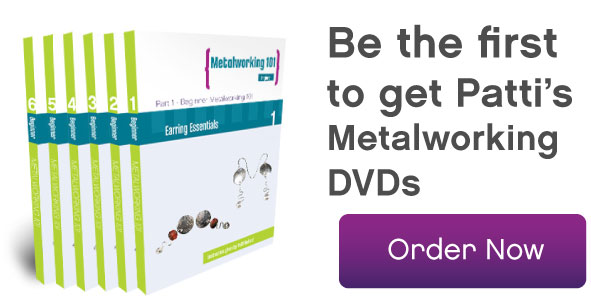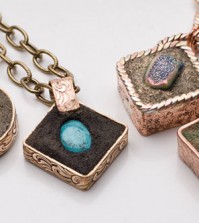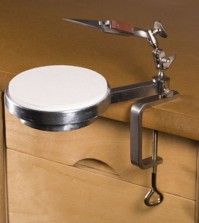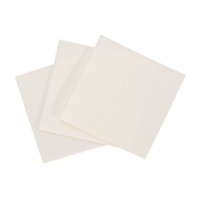- NEW DVD Series – Stone Setting with Bezels
- Tube Set Charm by Kim St. Jean
- Prong Basket Pendant by Kim St. Jean
- NEW DVD Series – Stone Setting with Cold Connections
- New DVD Series – Stone Setting with Wire
- NEW DVD Series: Introduction to Stone Setting by Kim St. Jean
- Featured Tool: Bracelet Bending Plier
- NEW Dvd by Eva Sherman
- Fun, Fast Fold Forming DVD Series
- Double Band Ear Cuff from Alex Simkin
Jewelry Tip: Soldering Tools and Soldering Vocabulary
by Rose Marion, Wire-Sculpture.com
Jewelry Resource for
February 27, 2013
What you need to know about Soldering!
Before you can start to solder, you need to speak the language! Patti Bullard introduced me to soldering lingo, and I’m excited to share it with you. There’s a lot of information about soldering online, but until you know what pickle and flux and pallions are, it can all sound Greek!
Patti goes over all these tools and concepts in her amazing DVD series, Beginner Metalworking 101, now available on preorder and shipping in 7-10 days. If you’ve already ordered her DVD set, this is a great preview of what you’ll be learning soon! This is a basic introduction – it’s nothing in comparison to watching Patti demonstrate each of the techniques and teaching you her little tricks!
- Solder
- A material that bonds 2 metal pieces together. Typically an alloy of silver and zinc, solder will join any non-ferrous metals together – that is, metals that don’t contain iron. There are specific solders that are gold-colored to match gold. Here are some great types of solder to work with:
- Easy solder
- Solder that comes in a sheet, that melts at a low temperature.
- Hard solder
- Solder that comes in a sheet, that melts at a higher temperature.
If you are going to be soldering a piece multiple times, joining more and more onto it, start with hard solder, so that it doesn’t reheat and melt or pit. - Wire solder
- Solder that comes in a wire. Gold-colored solder usually comes in this form, and it can be used just like sheet solder, cut into small pieces
- Paste solder
- Solder that comes in a paste, typically in a syringe. It can be used just like sheet solder and wire solder. This solder already has flux mixed into it, so you don’t have to flux first. (see below)
- Pallion
- A small square of sheet solder. You can use shears to cut your solder into pallions, or use solder-cutting pliers.
- Flux
- A compound used to clean metal before soldering. It also gives the metal a slight coating to prevent firescale from sticking to the metal.
Patti uses Aqui-Flux, which is self-pickling (that means less cleanup!) - Pickle
- A compound used to clean metal after soldering. This removes firescale. Patti uses Spar-ex in her pickle pot.
Simply mix into warm water to make your pickle. - Firescale
- The discoloration left after heating metal. This color change is typically due to copper. Pickling metal removes this extra copper, restoring the original metal finish.
- Sweat soldering
- Soldering a join by placing a pallion of solder between the pieces needing to be connected, then heating with a torch. This sandwich method is handy, and it’s the one most people think of when they think of soldering – much like gluing.
- Pick soldering
- Using an already-heated pallion of solder to solder a join. You ball the pallion with your torch, then lift it with a pick onto the join.
- Cold Connections
- Cold connections are the opposite of soldering – no heat! Wirework is one example of cold connections: for instance, wrapped loops, and all-wire bundles. You can also punch holes in metal and use rivets or tacks to create a join without using heat. (Patti’s #4 project, Mixed Metal Collage, uses tack rivets to create a beautiful 3D fall-inspired pendant!)
- Torch (& Butane)
- A handheld torch is the most important tool in soldering. Use triple-refined butane from the hardware store to fuel up a torch, like this one.
- Solderite Board
- Solderite is a brand of soldering board, an
asbestos-free, flame-resistant surface you can place your soldering project on as you create your jewelry piece. - Charcoal block
- A charcoal block is another material you can solder on, helping retain heat so you can solder faster, with better flow. Here’s a great charcoal block.
- Heat sink
- A heat sink isn’t a tool – in fact, you want to avoid heat sinks, if you can! A heat sink will pull the heat away from your project, meaning it takes longer to solder. An example would be extra pieces of metal on your soldering board, like extra tweezers or other projects.
- Third Hand
- A third hand is just that – another hand that you can hold your project with. Great for soldering the inside of rings and supporting long projects, a third hand has a tweezer grip and sometimes has a magnifier, too.
- Brass brush
- I showed you I picked up a brass brush in Tucson from JewelryTools – Patti showed me this trick and I was blown away! Whether you’ve soldered a piece or even just hammered some wire in regular wire wrapping, going over the piece with a brass brush will really bring out the shine. And it really won’t scratch the metal – this brush is so soft, you can run it over your fingers and it feels smooth, not like a wire brush. It even works cleaning off liver of sulfur – no more steel wool mess!
- Fire extinguisher
- This goes without saying – but keep a fire extinguisher at your workstation! With luck, you won’t need it – but just in case anything unexpected happens, you’ll have the situation under control.
How was that? Are there any soldering-related words I missed that you want to know about? Let me know in the comments! And remember to check out Patti’s DVDs – they’ll be shipping soon!
Have you seen the Metalworking 101 Trailer?
If you don’t already have Flash Player, click here
to install it in under a minute for FREE!
Have a Wire Jewelry Idea you’d like to share? Click Here to submit your idea. You could be featured on our Blog!
Click to Receive Daily Tips by Email

























Lori Crawford
February 27, 2013 at 7:34 pm
I am so glad you are going to be adding tips about soldering. Great addition to the site. Thanks so much!
Rose
February 28, 2013 at 10:50 am
Yes! We are so lucky to have Patti Bullard’s expertise. I’ve felt so bad not having the knowledge to answer soldering questions in the past – I’m glad we can be an even greater resource now!
Rose
Elizabeth Bisogni
February 28, 2013 at 6:47 pm
I think it’s a wonderful idea that you will been adding soldering and metalwork tips. Thank you for sharing, I appreciate it and look forward to new idea.